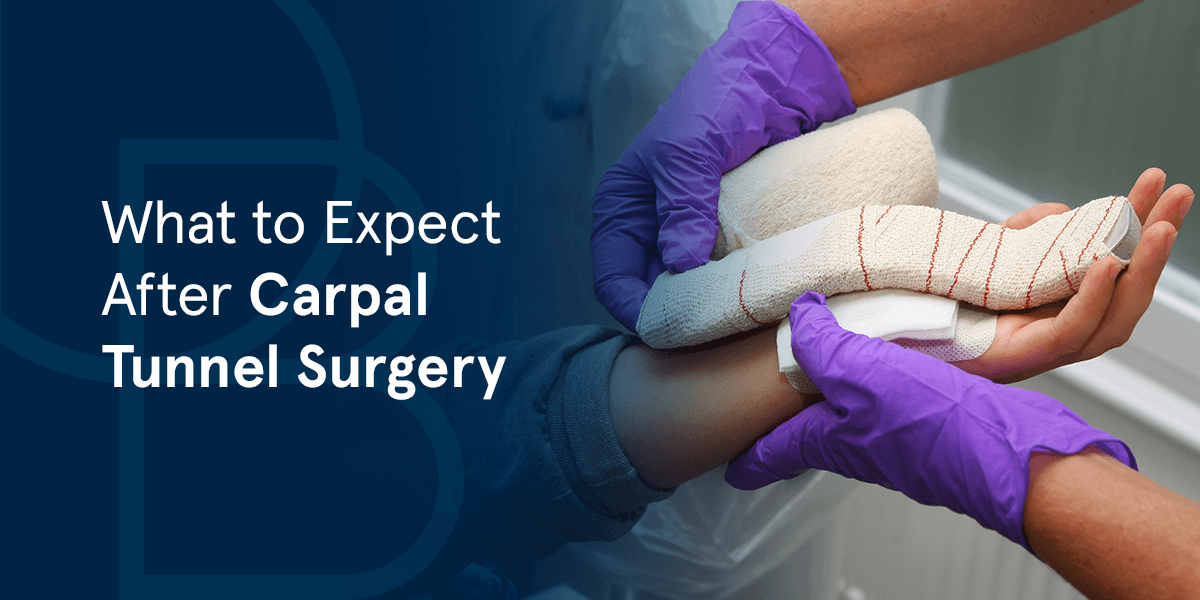
Carpal tunnel surgery is a routine procedure used to treat carpal tunnel syndrome, an overuse condition that develops from performing repetitive movements or a genetic disposition. The carpal tunnel consists of the transverse carpal ligament on top of the wrist and the wrist bones below. When tissues in this area swell, they put pressure on the median nerve, leading to numbness and pain. Symptoms tend to worsen over time.
Often referred to as carpal tunnel release, surgery offers an opportunity for relief from the symptoms. The surgeon cuts through the ligament applying pressure on the carpal tunnel, creating additional room for the tendon and median nerves.
What to Expect From Carpal Tunnel Surgery
With minimally invasive endoscopic surgery, your doctor can relieve the symptoms of carpal tunnel syndrome without the need for large incisions. In a single-portal surgery, you receive one tiny incision in the wrist. In a two-portal surgery, you receive an incision in the palm and wrist. The endoscope or a camera attached to a thin, flexible tube enters through the wrist incision to help your doctor see the carpal ligament.
After your doctor locates the carpal ligament, he will insert tiny tools into your incisions to cut and release the ligament. For a single-portal surgery, the endoscope contains a camera and a cutting tool, whereas, in a two-portal surgery, your doctor will insert a cutting tool through the palm. Cutting this ligament helps relieve median nerve pressure and eliminate your symptoms. Once your doctor cuts the ligament and removes his tools, he will close your incisions with stitches.
How Long Does Recovery Take?
You can return home on the same day once your carpal tunnel surgery is complete. The timeline to full recovery may vary depending on the severity of your carpal tunnel symptoms. Most patients experience minor pain and stiffness after surgery, which will fade over time. Your doctor will also give you some exercise to perform to prevent your hand from becoming stiff.
How to Take Care of Your Hand After Carpal Tunnel Surgery
Most patients wear a splint or heavy bandage for up to two weeks after surgery. You may need to have a follow-up appointment to remove the dressing.
If your hand is in a splint following the surgery, you should be sure to move your fingers periodically to combat stiffness. To reduce the swelling in your hand after surgery, you may have to keep your hand elevated while you sleep.
Following the removal of the splint, it’s time to begin physical therapy. You’ll engage in motion exercises to strengthen your wrist and hand, though you may still have to occasionally use the splint when your hand hurts.
Your surgeon may restrict your activities for some time after the surgery. For instance, if your work involves typing, you may have to stay home for a while or modify your work. How you progress after surgery depends on a number of factors, including:
- Age.
- Health and the presence of preexisting conditions, such as arthritis.
- How well you listen to the surgeon’s instructions.
You will see immediate progress soon after the surgery, but it could be three months to a year before you realize all the benefits of the procedure. Grip strength returns about three months afterward, and you can begin participating in sports about two months later as long as you don’t experience a lot of pain.
Best Exercises for Recovering From Carpal Tunnel Surgery
It’s important to start exercising your hand as soon as possible after surgery, generally your first day post-operation. Check out these basic exercises for your hand and wrist that will help you regain mobility and strength. When you first start these exercises, you should expect to feel some discomfort, though they should never be outright painful.
Tendon Gliding
Tendon gliding helps you regain your range of motion in your hands and fingers. Start by holding your hand up straight with your fingers upright and touching one another. Then, you’ll begin bending all your fingers aside from your thumb:
- First, bend them at your bottom knuckles at a 90-degree angle while keeping the rest of your fingers straight and together.
- Next, bend your second knuckles while keeping the rest of your finger straight.
- Finally, bend your fingers at the top knuckles to form a first.
- Straighten your bottom knuckles, then open your hand until it’s back in its original position.
Repeat this set of motions five to 10 times, depending on your pain levels.
Wrist Bends
Wrist bends will help increase flexibility and break up scar tissue. Extend your arm outwards with your wrist flexed at a 90-degree angle. Use your other hand to lightly pull your wrist back by your fingers and hold the position for 10-30 seconds. Repeat this stretch up to five times.
Thumb-Finger Touches
Thumb-finger touches improve your coordination in everyday tasks like picking up small objects and sorting. Simply hold your open hand up and touch each fingertip to your thumb, starting at the index finger and working through to the pinky before going back again. Complete this process three to five times in each direction.
What to Expect From Physical Therapy
Attending physical therapy after your carpal tunnel surgery is vital for preventing scar tissue formation and restoring strength to your wrist. Your physical therapy treatment may include:
- Scar management.
- Wrist exercises.
- Wrist and finger stretching exercises.
- Wrist and hand muscle strengthening exercises.
- Education about proper posture and wrist position.
- Resources on how to create the proper workstation setup.
Pain and Numbness After Carpal Tunnel Surgery
Your surgeon usually bandages your hand following carpal tunnel surgery. You may notice it feels numb, a sensation that comes and goes. It could also feel tingly before becoming numb.
It’s normal to feel some pain or discomfort following carpal tunnel surgery. Your hand may feel pain for several weeks afterward. If it persists for longer than that, you should talk to your doctor. Your surgeon may prescribe medicine to help you with the pain, and you can also ice the area to reduce swelling.
Driving After Carpal Tunnel Surgery
You can resume driving once you have regained the full functionality of your hand. You need to be able to react quickly when you drive, and if your hand still hurts, your reaction time may be compromised.
Tips for Avoiding Carpal Tunnel Post-Recovery
After recovering from surgery, the last thing you want to do is risk developing carpal tunnel syndrome again. Fortunately, there are many methods to reduce your risk of developing severe symptoms. Taking breaks from repetitive activities, improving your posture and following ergonomic guidelines are a few examples of ways to prevent carpal tunnel syndrome at home, at work or while gaming.
When to Call a Doctor
It’s essential to attend all follow-up and physical therapy appointments after surgery. If you are experiencing any of the following, call your doctor immediately:
- Pain after taking medication
- Cold hands or hands that are changing color
- Your bandages feel too tight
- Weak or numb feeling in your hands
- Feelings of nausea
- Loose stitches
- Pain in the calf, knee, thigh or groin and redness and swelling
Call emergency care immediately if you lose consciousness or are experiencing chest pain or shortness of breath.
Contact OrthoBethesda to Learn More
Do you need carpal tunnel surgery or have questions about the procedure? Contact our office today or make an appointment with our team.

